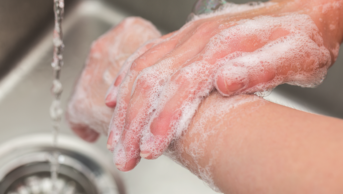
Lightpoet/Shutterstock
Hospital employees who work with patients wash their hands less frequently as they get deeper into their shifts, according to a study published in the Journal of Applied Psychology
[1]
.
The researchers found that hand-washing compliance rates dropped by an average of 8.7 percentage points over a work shift — the compliance rate was 42.6% in the first hour of a work shift but had fallen to 34.8% in the last hour of a typical 12-hour work shift. As work intensity increased, the researchers found that compliance adherence fell even more quickly.
“For hospital caregivers, hand-washing may be viewed as a lower-priority task,” says Hengchen Dai, lead author of the study, and a PhD candidate at the Wharton School, University of Pennsylvania. “It appears that compliance with hand-hygiene guidelines suffers as the workday progresses.”
Lower levels of adherence may occur because the execution of the primary tasks associated with the job becomes the priority, with workers often additionally burdened with physical, mental and emotional job demands, Dai says.
“As a result, people’s self-regulatory capacity — which is their ability to control their emotions and behavior to respond in a socially desirable way — declines, especially as they become more and more fatigued,” she says.
Longer breaks between work shifts correlated with increased compliance. The study notes that taking an additional 12 hours off is linked with a 1.3% increase in the odds that a caregiver is compliant when faced with a given hand hygiene opportunity on a subsequent shift.
The World Health Organization (WHO) has noted that the rate of compliance with hand-washing standards is not always high, ranging from 5% to 89%, with an average rate of 38.7%[2]
. The study notes that compliance rates are below 50% in most healthcare settings according to systematic reviews of hand hygiene compliance.
The data for the study were provided by Proventix Systems, which has a point-of-care, compliance-monitoring system that uses radio frequency identification (RFID) technology to help hospitals motivate their healthcare staff to follow hand-hygiene standards. It was collected over three years and involved 4,157 caregivers in 35 hospitals and 56 hospital units in the United States, comprising nurses (65%), patient care technicians (12%), therapists (7%) and physicians (4%) and other employees (12%). Proventix’s measurement system involves hand hygiene to be executed on both entry into and exit from patient rooms, when the stay is 20 seconds or longer. Each caregiver’s hand-washing compliance or non-compliance, through the course of each shift, was captured by RFID technology.
“It’s important to note that even small improvements in complying with hand-hygiene guidelines can be valuable, especially when immediate and continuous job demands can easily take their toll,” says Dai.
References
[1] Dai H, Milkman KL, Hofmann DA et al. The impact of time at work and time off from work on rule compliance: the case of hand hygiene in health care. Journal of Applied Psychology 2014.
[2] World Health Organization. (2009). WHO guidelines on hand hygiene in healthcare. Geneva, Switzerland: World Health Organization Press.
You may also be interested in

Hand hygiene interventions could lower death rates in nursing home residents

Jeremy Miles praises “incredible” work of pharmacists, and announces government-commissioned RPS review of general practice pharmacy
